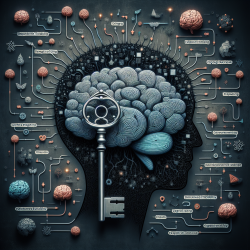Introduction
As a practitioner in the field of mental health, staying informed about the latest research can significantly enhance your therapeutic skills. One such groundbreaking study, "Repetitive negative thinking in daily life and functional connectivity among default mode, fronto-parietal, and salience networks," sheds light on how brain networks influence repetitive negative thinking (RNT) and offers insights into improving therapeutic approaches.
The Role of Brain Networks in Repetitive Negative Thinking
Repetitive negative thinking (RNT) is a maladaptive response to sadness and a transdiagnostic risk factor for various psychopathologies. The study explores how the functional connectivity among three critical brain networks—the default mode network (DMN), fronto-parietal network (FPN), and salience network (SN)—affects RNT. Understanding these connections provides a framework for developing strategies to mitigate RNT in patients.
Key Findings and Implications for Practice
- DMN and FPN Connectivity: Increased connectivity between the DMN and FPN is associated with higher RNT following sadness. Practitioners can focus on interventions that enhance cognitive control and attentional flexibility to reduce this connectivity and, consequently, RNT.
- FPN and SN Connectivity: Lower connectivity between the FPN and SN is linked to increased RNT. Encouraging activities that boost cognitive control resources may help strengthen this connectivity, thus reducing RNT.
- SN Flexibility: Greater flexibility of the SN is protective against RNT. Techniques that promote cognitive flexibility, such as mindfulness and cognitive-behavioral strategies, can be beneficial in managing RNT.
Practical Applications for Therapists
Implementing the findings from this research can enhance therapeutic outcomes. Here are some practical steps therapists can take:
- Mindfulness Training: Incorporate mindfulness practices to improve SN flexibility and cognitive control.
- Cognitive-Behavioral Techniques: Use CBT to address maladaptive thinking patterns and enhance cognitive flexibility.
- Neurofeedback: Consider integrating neurofeedback to directly influence brain network connectivity and improve cognitive control.
Encouraging Further Research
While this study provides valuable insights, further research is necessary to fully understand the complexities of brain networks and their role in RNT. Practitioners are encouraged to stay informed about ongoing research and consider participating in studies that explore innovative therapeutic approaches.
To read the original research paper, please follow this link: Repetitive negative thinking in daily life and functional connectivity among default mode, fronto-parietal, and salience networks.










